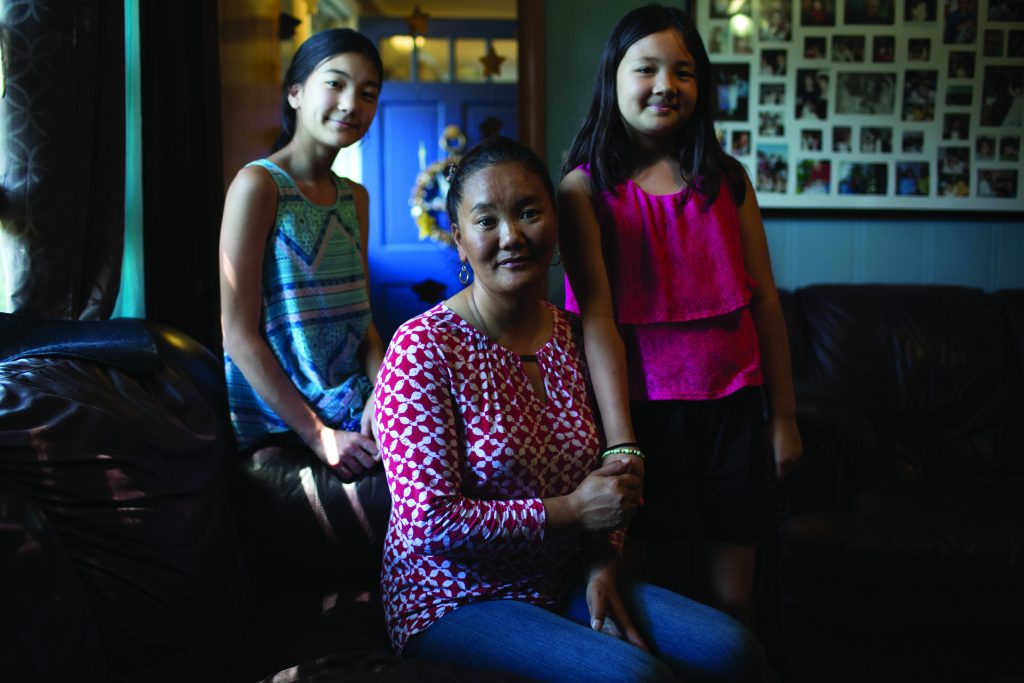Age: 43
Profession: Mountain Climber & Housekeeper
Location: West Hartford, Connecticut, originally from Nepal
In May 2016, you summited Mount Everest for the seventh time, and you’ve held the women’s record for the most summits since 2006. How did it feel to be back at the top after a ten-year break? I was at Everest last year and I reached base camp. Then the earthquake came. So I wasn’t able to summit, even though I did start to climb. I’m very sad, because we lost many people, many climbers. Everything was affected: my family’s village, all of Nepal is very bad.
But it wasn’t any different climbing this time. In my heart, I like living in the mountains. I have some problems and I think, “Ah, mountain season is coming. I want to get my boots and run away to the mountain.” I’m leaving my two girls here in the U.S., and it’s hard, but in my heart I want to climb this mountain again and again.
How long did it take you to summit? Two months. My expedition was on a very tight budget—we had ten Sherpas and nine climbers, and we reached the summit at 5 in the morning. We were up all night. This year I counted seven dead bodies.
When I go to Everest, the tourists who hire me as guides pay me $6,000, and if we get to the top of Everest it’s another $1,000. If these people don’t summit, I don’t get the bonus money to give to my children.
When I’m on the mountain, I’m quiet. On the mountain, only my team knows that I’ve summited seven times. I don’t tell other people, other groups. But this time, one woman who had read about me on the Internet said to me, “You are Lhakpa. You are Super Mom!” And all the people called me Super Mom! No one believes I have three children [Nima, 20; Sunny, 13; Shiny, 9]. Climbing Mount Everest is my job, my passion. Women can do anything—they can have babies, they can cook, and they can climb mountains.
You carried banners from both of your daughters’ schools to the summit. Why? I carry things with me that I like and respect. These schools give so much education so that many smart children can become doctors and lawyers. This education is very important for my children. I have never been to school, but I can carry the banner of the school to the top.
I know how the system works. If you don’t have an education, you have a problem with jobs. In Sherpa culture, Sherpas work in the mountains because they don’t have an education—they must go up. They must go to dangerous areas. People die, they keep going. I must keep working, like a yak. For $6,000, I could give my life. Maybe I die, maybe I can bring $6,000 to my children. This is my job.
It seems like you live two different lives—one in Nepal as an accomplished climber and another in Connecticut as a housekeeper. It is a different life. I’m very confused here. On Everest you go up one way and come down one way. But here I see so many roads. I feel like I’ve been thrown in a big ocean and nobody has come to rescue me.
Do you think your children will want to climb? Would you like that? My children never say that they want to go to Everest. But my girls say, “Mama, you summit many times, I know you’ll come back.” The little one [Shiny], she is a little bit worried. My son doesn’t want to climb, either. He says, “You go to mountain, we go to school.”
What is the role of Buddhism in your life, both in Connecticut and when you go to Nepal to climb? I practice on the inside. If I go to the temple I would be in big trouble, because it has been a long time since I went. I just keep it inside my heart.
I have a big respect for Everest. In my culture, the mountain is a mother. When I see Mount Everest, I pray. I say, “Please, Mother, I have three children waiting. Don’t kill me. Please let me come back.” And I know in my heart, I believe that this mother, this mountain, won’t kill me, because I have to be with my girls here. My children are waiting. When you’re on Everest, it fights you, but I believe I’m fighting Everest back.
For more on Lhakpa Sherpa, visit tricycle.org/trikedaily/lhakpa-sherpa.
Thank you for subscribing to Tricycle! As a nonprofit, we depend on readers like you to keep Buddhist teachings and practices widely available.
